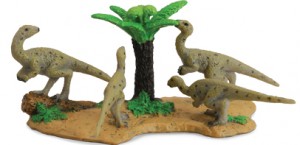New Insight into Hypsilophodon – The Anatomy of an Olympic Runner
New Study Suggests Hypsilophodon was built for Speed
Today at the Beijing Olympics, attention turns to the beautiful National stadium affectionately called the Birds Nest Stadium as the track and field events get underway. The heats for the 100 metres will be taking place, who will be the fastest runner on the planet? Few commentators and pundits expect the British athletes to be amongst the medals for this particular event. However, a new study by scientists, shows that one ancient resident of Great Britain could have given the top sprinters a run for their money.
Hypsilophodon
Although it would have stood only waist-high next to an Olympic sprinter, the small British ornithopod Hypsilophodon foxii had a fair turn of speed, and new research suggests it even may have possessed a special adaptation that prevented its ribs from rattling during its speedy runs.
This new paper, published in the scientific journal Cretaceous research helps shed light on a mystery surrounding this small, agile dinosaur. A number of mineralised plates have been found in association with Hypsilophodon fossils. It had been speculated that these were scutes, pieces of dermal armour that were embedded in the skin of this lightweight dinosaur. However, such armour would have only provided limited protection from fierce meat-eating carnivores such as Neovenator and other members of the Allosauridae. More importantly, the heavy armour would have slowed this animal down and seemed to contrast with other anatomical adaptations seen in the numerous fossil skeletons of this dinosaur that indicate a fast running animal.
These thin mineralised plates, once believed to be pieces of body armour may actually have been robust cartilage tissues that may have supported the ribs and helped regulate breathing, especially as Hypsilophodon exerted a lot of energy, running for example.
“Hypsilophodon had elongated legs and a stiffened counterbalancing tail that suggest it was almost certainly a fast runner” commented Richard Butler one of the co-authors of the study. Richard, a member of the palaeontological team at London’s Natural History Museum added; “the plates might have functioned to support the ribcage during fast running”.
Hypsilophodon remains are relatively common in Lower Cretaceous strata of both Europe and America. The Hypsilophodonts were a highly successful group and a number of superbly preserved fossil specimens are known. This animal was named and described in 1869. At the time of its formal classification, British Zoologist Thomas Huxley commented that with its five-fingered hands and light body this dinosaur could have lived in trees. A number of illustrations were made of this arboreal dinosaur and depictions of Hypsilophodon sitting comfortably on a conifer branch can be found in many old dinosaur text books from the 1970s and 1980s.
A Small Model of the Dinosaur Called Hypsilophodon
The model (above) is part of the: CollectA Prehistoric Life Model Range.
Previous descriptions of Hypsilophodon fossils describe these little plates as components of dermal armour, perhaps a double row of plates running down the spine. Now Butler and his associates have a different explanation for the finding of these items with fossils of this particular dinosaur. The team noted that the plates were weakly constructed and overlaid but were not actually fused to the ribs. Butler explained the previous interpretations by saying: “that as the body of the dead Hypsilophodon individual rotted and collapsed…the bones from the skin came to be closely associated with the internal bones.”
“Our careful reexamination of the specimens shows, however, that the bony plates are always closely associated with the outside surface of the ribs from the front end of the ribcage and are certainly not armour,” he added.
The Natural History Museum scientists believe the plates were similar to the bony structures referred to as “uncinate processes,” seen in the rib-cages of many modern birds. Although it is not clear whether dinosaurs had the same breathing systems as birds. Since this feature is involved in bird ribcage support, facilitating movement and breathing, the scientists now suspect the structures played a similar role in the dinosaur.
Diagrams show part of the scapula and ribs of a Hypsilophodon specimen from the London Natural History Museum, the scapula (shoulder blade is labelled “scap”, ribs are labelled as are the mineralised plates “pl”. They do seem to be closely associated with the rib bones and not likely to be dermal armour that has fallen into the skeleton as the animal’s flesh decomposed. Perhaps they are intercostal plates helping to regulate breathing during arduous exercise.
The British team have suggested that because evidence for similar mineralised plates has been detected in other dinosaur skeletons, the researchers further theorise that all small-bodied, bird-footed dinosaurs possessed these structures.
Darren Naish, of the University of Portsmouth’s School of Earth & Environmental Sciences, is also intrigued by the fact that the structures could be “widespread, possibly even universal” in other small, herbivorous dinosaurs.
Naish added, “People have mostly forgotten about these ‘armour plates’ in recent decades, but this new work shows that a fresh look at old specimens can still reveal new information on even the best known of dinosaurs”.


